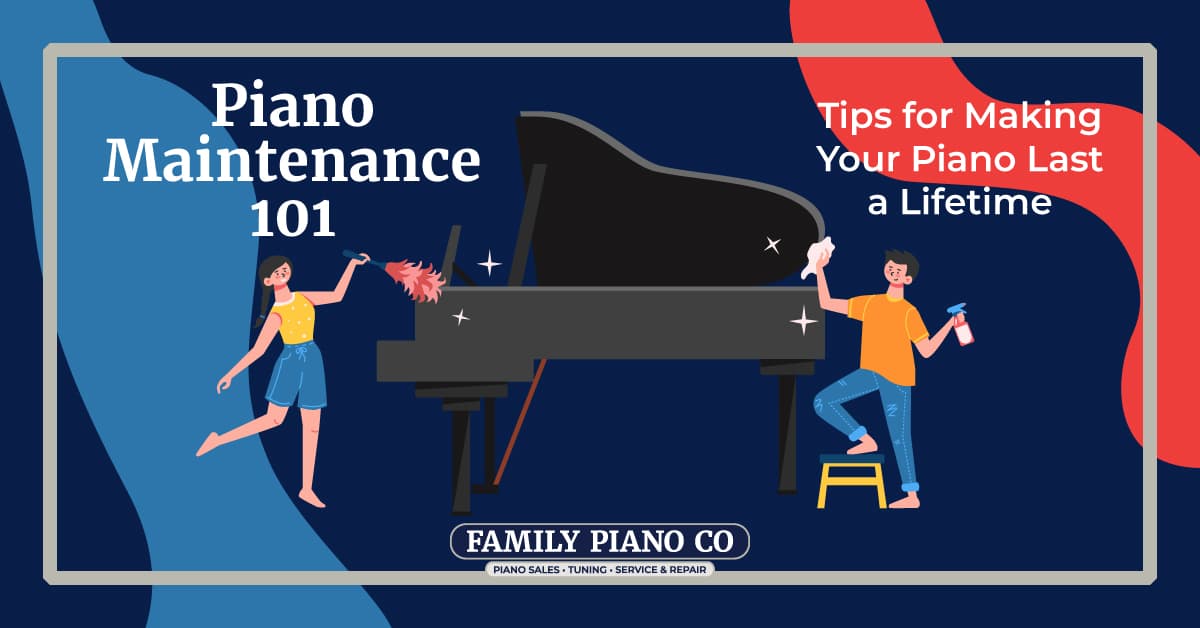Piano maintenance might not be everyone’s favorite topic. But it’s important to understand how to take care of your piano so that you can enjoy playing it for as long as possible!
Acoustic pianos are pretty delicate instruments, despite what one might think based on their huge weights and sizes. They’re made of natural materials and have many tiny parts and pieces.
And while the case of longevity isn’t typically as relevant for digital pianos, we still think it’s important to prevent problems early on — and to maximize any potential resale value!
We’ve kept these guidelines as simple as possible while still being thorough enough to cover every major concern.
Of course, if you have any additional questions, please do leave a comment. We’re also happy to respond directly to calls and emails as well!
Preventing Issues: 8 Do’s & Don’ts
The best way to avoid piano maintenance issues is by maintaining the piano’s condition in the first place. In some cases that’s easier said than done. But in this one, it’s actually pretty simple!
1. Do wash your hands before you play. Grime gathers on keys quicker than you might think. Make sure your hands are clean before you touch your piano.
2. Don’t touch the case too much. Polished pianos especially can be fingerprint magnets. You won’t have to clean fingerprints and if there aren’t any in the first place!
3. Don’t leave the lid open too often. Despite how beautiful a grand piano looks when it’s open, you may not want to leave it open all the time. More pet hair and dust can build up inside, and there’s a higher risk for things falling in accidentally too.
4. Don’t touch the inside. Again, a piano’s guts are delicate and sensitive. Just one tiny part being out of place can cause a whole key to stop working. Best to call an expert whenever you have a mechanical issue. Or even whenever a pencil falls in!
5. Don’t put stuff on the piano. While a vase of flowers certainly makes for beautiful decor, we advise not using your expensive instrument as an expensive shelf. You want to minimize the chances of an accident happening as much as possible. And this especially includes food items, lit cigarettes and drinks — keep them away from your piano!
6. Do consider protective accessories. Bench pads are easy ways to make playing sessions more comfortable, and to prevent damage to your bench. Caster cups spread the weight of your piano, great for preventing damage to your floor or carpet. And you could even consider a Dampp Chaser Piano Saver System (preferably with the undercover for grands) to easily regulate your acoustic pianos humidity (MUCH more important for your piano’s tuning and mechanical stability than the temperature).
7. Do tune often. An in-tune piano has over 40,000 lbs of string tension balanced across about 240 strings. Neglecting tuning will decrease the tension and deteriorate this delicate balance. So tune regularly — even if you’re not playing much! Don’t be embarrassed to call your technician, even if it’s been “a while.” Those little parts and joints will stiffen up!
8. Do play often. This is actually very important so you get to know your instrument. If you know how your piano should feel and sound, you’ll be quicker to identify when something is wrong is needed. Not to mention — enjoying and making music is what your piano is for!
How to Place a Piano in a Room
A piano is a wonderful addition to almost any room, so enjoy it’s beauty without stressing out too much.
That said, especially if you have an acoustic piano, proper placement is important part of piano maintenance to consider.
We give a quick rundown below, but we’ve also written a dedicated blog with more Piano Placement Tips!
Find a Spot with Consistent Humidity
If there’s one thing you walk away from this blog post with, let it be this: pianos hate humidity swings!
Fluctuations in humidity are problematic for wood — the soundboard especially — one of the most important and most delicate parts of a piano.

Underneath everything on a grand piano's tail, you'll see a big, flexible and thin piece of wood. That's the soundboard which amplifies the strings' sound!
When the soundboard swells or contracts even slightly, string tension is affected unevenly which leads to the tuning being off. More importantly, the wood fibers in the soundboard will stretch and contract, potentially leading to cracks. Huge issue you want to avoid!
For this same reason, never place an acoustic piano near heating or AC vents without modifying the vents!
Out of Direct Sunlight
We’d also recommend placing your piano away from windows. This is partly for more consistent humidity/temperature. But it’s also to keep direct sunlight off the piano!
The sun can be terrible for a piano’s finish, fading or cracking especially the natural wood tones, and showing more dust on any piano too. If a room only gets moderate sunlight though, blinds or sheer drapes will often suffice.
Consider Adding a Humidifier
It’s true that in properly-insulated homes, many of these points won’t be a severe problem. But if you aren’t confident that’s the case — or if you tend to open nearby windows often — it’s best to be safe. That’s why we often recommend either:
1) Installing a Dampp Chaser Piano Life Saver System that’ll take care of your instrument’s humidity (including the optional undercover in the case of grand pianos). This is the easiest and most effective way of managing humidity and a giant help in ensuring top-tier piano maintenance.
2) Getting a humidifier and/or dehumidifier for the room your piano is in, and monitoring it regularly.
Make Enough Space
Now, while these points don’t hold as much significance for digitals, a tip that’s applicable to all pianos is to mind the traffic.
If you place your piano in areas people often walk by, someone might accidentally bump into it and hurt themselves or the piano. So give your piano space!

For slab-and-stand digitals and keyboards, X-stands like the one used above are fine for gigging and occasional use. But for the best stability in-home, we recommend a proper high-quality stand!
On a similar note, you may need to make some room for the piano. We recommend taking specific measurements of the instrument, then using placemats to better visualize how it’ll fit in your space. Most piano stores should have a sturdy paper template you can borrow. If those are unavailable, you can just place down painters tape to check there won’t be any spaces that are too tight.

Specifics will depend, but upright pianos usually measure around ~58" wide, 21-25" deep, and 36-60" tall. Grand pianos will be around 58-60" wide, 4'8"-9'0+ deep, and ~40" tall (lid closed). 88-key digital piano slabs vary the most, but start at about 50"+ wide, 10-18" deep.
On a final note, pianos are heavy. They can tip during moves, injuring amateurs for life. It’s usually best to hire professionals if moving it — sometimes even if just from one room to another.
So you really want to make sure you carve out a nice spot that it’ll be happy in for years and decades to come!
How to Clean a Piano
Cleaning the different parts of your piano starts with a lot of consideration. There are many things that will depend on your piano’s finish and type, and we’re giving general guidelines that have a lot more nuance.
More than anything, we encourage you to ask your technician for tailored advice. You really want to be careful so you don’t damage your piano! You don’t want piano maintenance to turn into piano repair!
What to Use to Clean the Cabinet
Water is perfectly fine. In fact, we recommend just that if you’re only kicking off dust and fingerprints.
That said, only use damp soft cloths plus a dry soft cloth. No paper towels since they may scratch your piano. And wipe away excessive liquid constantly so you don’t invite harm to the wood or electronics.
While we can’t speak to every exact finish, here are the three most common finish types and how to clean them:
Modern Polyester Finishes – Closely related to the plastics used in eyeglass lenses. It’s waterproof and highly-durable so most simple cleaners will be fine ie. ammonia, hydrogen peroxide, vinegar. No oils or waxes! Be mindful that it can scratch or chip.
Satin Finishes – One of the harder finishes to maintain since it’s a magnet for body oils. If you overclean, it’ll start to gain shine over time. Using a specialized cleaner is preferable, and make sure to to wipe in the direction of the finish’s grain.
Lacquer Finishes – Many older pianos are finished in nitrocellulose lacquer. In this case, you may use the same products you likely already own and use on your other fine lacquer furniture, but do NOT get them on the keytops or into the action!
Not confident what your piano’s finish is? Ask your technician — and ask them for specific cleaning product recommendations! Definitely be careful!
One other piece of advice: do not get creative with cleaning agents. People sometimes use milk to whiten ivories, toothpaste for ebony keys, etc. Just don’t! And never use bleach either!
How to Clean Different Parts of a Piano
Keys – Dust, dirt, and oil accumulates on a piano’s keyboard pretty quickly. Not only is it icky, but it can also affect your grip. Be very careful not to get liquid in between the keys — you do not want that wood to swell! Use very little water/solution, and wipe away the excess immediately.
Case – Again, mind excess water and be sure to use as soft a cloth as possible. You want to avoid scratching the case or damaging the finish with harsh cleaning solutions. After cleaning an acoustic piano, you can polish the piano if you feel it needs an extra shine. We recommend Cory’s polish, which has a solution for every finish (and we do sell it in-store and online).
Pedals & Hardware – Check for flaking plating, but most pedals, knobs, music desk brackets are solid brass. They can be cleaned with readily available metal cleaners such as Flitz or Brasso. You may want to protect surrounding surfaces with masking tape, especially anything absorbent like felt to avoid staining or hardening.
Not every technician enjoys or even does cleaning, but we’re happy to! And it’s a modest upcharge if combined with a tuning! Contact our service manager to get scheduled if you’re in the Chicagoland area.
How Often to Clean Your Piano
All this said, piano cleaning typically isn’t a major concern for piano maintenance, and your instrument probably doesn’t need as much cleaning as you might think.
If the piano is particularly dirty, you probably need to do some more preventative care ie. washing hands, keeping in a cleaner environment, etc.
Our recommendation for acoustic pianos is to focus on kicking off excessive dust and fingerprints. This can be done on an as-needed basis.
We also strongly recommend having your acoustic piano’s technician regularly monitor the insides. We’ve seen some pretty grimy actions and soundboards over the years. Having a cleaning done during your annual tuning every few years — not a bad idea!
Regular Tuning & Tech Appointments
This is the single best thing you can do for your acoustic pianos longevity. Schedule technician visits regularly, and you can consider your piano maintenance solid.
Because basically, a good technician is going to take care of your piano for you. They’ll even correct mistakes you might’ve made if you missed out on the previous tips!
How Often to Tune a Piano
There isn’t a simpler way to say this: your piano needs to be tuned regularly. Not only does it help the tuning stability over the long-term, but it also gives technicians the chance to ensure your piano is working the best it possibly can.
Playing an untuned piano is a huge detriment to all players. To beginners, it makes ear training a far greater challenge than it already is. And to more experienced players, it’s anywhere from annoying to grating.
So we highly recommend you have an expert look at your piano at least every year. In the case of more avid players, you’ll definitely benefit from a visit every 6mo — and your piano will too!
If you have a new piano, we strongly recommend tunings every 6mo too. It makes a huge difference for decades! The closer to in-tune the piano is beforehand, the more precise and stable the tuning will be.
This is also a good time to mention that you should not try tuning your own piano. Piano technicians have to balance over 40,000 lbs of string tension across 230 strings. It’s tempting to try and save money each year, but it’s really not worth your time or effort to learn for just your piano.
Prepare for Occasional Piano Repairs
Of course, tunings just deal with the pitch of the piano’s strings. Your piano’s action will also require regulation over time as tiny parts shift or wear out.
In some ways, a piano tuning is like getting your car’s oil changed. It’s the very least you have to do, and the car will last longer if you get it done regularly. But it doesn’t fix the squeaky brakes, faulty radiator, electrical issues, etc.
A technician should be able to identify apparent issues with the mechanism as they tune your piano. But if there’s anything you’ve noticed, do let them know upfront. This is preferably done as you schedule the tuning so that they can quote you accurately, bring any necessary parts, and schedule enough time for the appointment.
Find a Piano Technician First
One final note is that technician availability should be checked before you buy a piano. In some places in the United States, there simply aren’t people that can service your piano sometimes.
In these cases, the instrument’s longevity will simply be cut short. It’s unfortunate to say, but we do hear this being the case for digital pianos especially. Find a good technician first!
Prosper with Proper Piano Maintenance
It’s important to take care of your piano for many reasons. Neglected pianos tend to be more expensive in the long-term, and they’re simply not as enjoyable to play.
At its simplest, all you have to do to ensure proper piano maintenance is:
1) not damage it,
2) put it in a safe place,
3) clean it only as necessary,
4) schedule tunings at least yearly (for acoustic pianos).
We’ve seen digitals from 1970s that still play really respectively, and acoustic pianos that have lasted well over 100 years. Following these tips, we think yours can last that long too!





I can see how while piano maintenance may not be the most exciting subject, it’s crucial to have a basic understanding of how to care for your instrument to ensure its longevity. You said that proper maintenance allows for enjoyable and quality playing for years to come. I will share this insight with my friend who is in need of piano tuning services, as it may help them maintain their piano and avoid costly repairs. By taking care of their instrument, my friend can continue to enjoy playing music for years to come.
My aunt told me she was going to give me her old piano when I told her that I was interested in learning how to play but told me that it still needs tuning before I can use it. I appreciate your advice when you told us that it is recommended to have our piano tuned at least once every year since not doing so will make ear training quite challenging for beginners. I’ll take note of this while I look for a service provider to hire for piano tune adjustment soon.